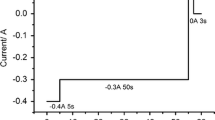Abstract
The LiF-ThF4 system has been considered as reference fuel solvent for molten salt reactor. The high-temperature interaction of LiF-ThF4 leads to formation of a number of complex fluoride compounds. The study is focused on determination of experimental thermodynamic properties of the compounds in this system. The Gibbs energy of formation of LiThF5 (s), LiTh2F9 (s), and LiTh4F17 (s) has been measured by solid electrolyte galvanic cell method and the Gibbs energy of formation of these compounds as a function of temperature were expressed as
The heat capacities of these compounds were also measured using differential scanning calorimeter. Using the experimental thermodynamic data, the thermodynamic tables of LiThF5 (s), LiTh2F9 (s), and LiTh4F17 (s) were constructed and the ternary phase diagram of Li-Th-F system was calculated to study the stability domain and coexisting phases of these compounds.











Similar content being viewed by others
References
Blumberg R (1967) Maintenance Development or Molten-Salt Breeder Reactors ORNL-TM-1859. Oak Ridge National Laboratory
Perry AM, Bauman HF (1970) Nucl Appl Techn 8:208–215
Briggs RB (1963) Molten Salt Reactor Program Semiannual Progress Report for Period Ending July 31, 1963, ORNL-3529. Oak Ridge National Laboratory, Oak Ridge
Vijayan PK, Basak A, Dulera IV, Vaze KK, Basu S, Sinha RK (2015) Pramana. J Phys 85(3):539–554
Sinha RK (2011) Energy Procedia 7:34–50
Kasten PR (1967) “Safety program for molten-salt breeder reactors,” ORNL-TM-1858. Oak Ridge National Laboratory
McCoy E, Weir JR (1967) Materials development for molten salt breeder reactors, ORNL-TM1854. Oak Ridge National Laboratory
Macpherson HG (1969) “Molten-Salt Reactors,” Proceedings of the International Conference on the Constructive Uses of Atomic Energy, Washington, DC, November 1968, American Nuclear Society
Delpech S, Merle-Lucotte E, Heuer D, Allibert M, Ghetta V, Le-Brun C, Doligez X, Picard G (2009) J Fluor Chem 130(1):11–18
Beneš O, Beilmann M, Konings RJM (2010) J Nucl Mater 405(2):186–198
Capelli E, Beneš O, Beilmann M, Konings RJM (2013) J Chem Thermodyn 58:110–116
Capelli E, Beneš O, Konings RJM (2015) J Nucl Mater 462:43–53
Bird JM, Bryant AW, Pratt JN (1975) J Chem Thermodyn 7(6):577–586
Bugden WG, Pratt JN (1969) J Chem Thermodyn 1(4):353–361
Pratt JN (1990) Metall Trans A 21(4):1223–1250
Wagner C (1968) J Electrochem Soc 115(9):933–935
Wagner C (1953) J Chem Phys 21(10):1819–1827
Jacob KT, Iyengar GNK (1999) Metall Mater Trans B 30B:865–870
Ramasesha SK (1989) J Appl Electrochem 19(3):394–400
Jacob KT, Rajitha G (2011) J Chem Thermodyn 43(1):51–57
Jacob KT, Waseda Y (1994) Thermochim Acta 239:233–241
Fitzner K (1983) Zeitschrift fuer Metallkunde 74(11):755–757
Hohne GWH, Hemminger WF, Flammershein HJ (2003) Differential scanning calorimetry, second edn. Springer, Berlin
Mukherjee S, Dash S (2019) J Solid State Electrochem 23(1):307–314
Barin I, Knacke O (1973) Thermochemical properties of inorganic substances. Springer - Verlag, New York
Mukherjee S, Dash S (2017) J Solid State Electrochem 21(12):3589–3597
Mukherjee S, Dash S (2018) J Fluor Chem 212:17–25
(1997) PDF-2 Database, Powder Diffraction File, International Centre for Diffraction Data, Pennsylvania
Kopp H (1865) Philos Trans R Soc Lond 155:71
Leitner J, Voňkab P, Sedmidubský D, Svobodae P (2010) Thermochim Acta 497(1-2):7–13
Lukas HL, Fries SG, Sundman B (2007) Computational thermodynamics, the Calphad Method. Cambridge University Press
Kaufman L, Bernstein H (1970) Computer Calculation of Phase Diagrams. Academic Press, New York
Pelton AD, Chartrand P, Eriksson G (2001) Metall Mater Trans A 32A(6):1409–1416
Mukherjee S, Dash S, Mukerjee SK, Ramakumar KL (2015) J Nucl Mater 465:604–614
FactSage Version 6.3, “The Integrated Thermodynamic Data Bank System”. GTT Technologies, GmbH, Germany, pp 1976–2006
Acknowledgments
The authors are thankful to Dr. S. Kannan, Head, Fuel Chemistry Division, for his constant support and encouragement. The authors are also thankful to Smt. Geeta Selke for X-ray diffraction analysis of the samples.
Author information
Authors and Affiliations
Corresponding author
Additional information
Publisher’s note
Springer Nature remains neutral with regard to jurisdictional claims in published maps and institutional affiliations.
Rights and permissions
About this article
Cite this article
Mukherjee, S., Dash, S. Determination of Gibbs energy of formation of LiThF5, LiTh2F9, and LiTh4F17 in Li-Th-F system by using solid electrolyte galvanic cell. J Solid State Electrochem 23, 3043–3056 (2019). https://doi.org/10.1007/s10008-019-04404-4
Received:
Revised:
Accepted:
Published:
Issue Date:
DOI: https://doi.org/10.1007/s10008-019-04404-4




